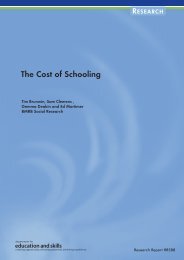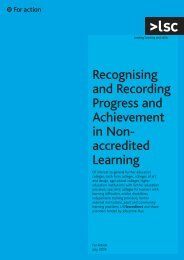Faiths and further education - Church of England
Faiths and further education - Church of England
Faiths and further education - Church of England
- No tags were found...
You also want an ePaper? Increase the reach of your titles
YUMPU automatically turns print PDFs into web optimized ePapers that Google loves.
19Spirituality …Well, yes, but what is it …?43This NEAFE <strong>and</strong> <strong>Faiths</strong> in FE Forum initiative is about encouragingan integrated approach to chaplaincy in colleges, in terms <strong>of</strong> theprincipal, managers <strong>and</strong> teaching <strong>and</strong> support staff.Though themanagement <strong>of</strong> any chaplaincy activity is important, its mainemphasis will be on spirituality <strong>and</strong> spiritual development.Thefollowing section attempts to encapsulate discussions about suchterms that have taken place at NEAFE, the NEAFE <strong>and</strong> LSC WorkingGroup <strong>and</strong> <strong>Faiths</strong> in FE Forum meetings.The omnipresent need for spirituality44It is not an over-ambitious assertion to say that it is an essentialpart <strong>of</strong> the human condition to want something more than meresurvival, though survival, <strong>of</strong> course, should not be underestimated.This ‘more’ can take an obvious form, as in the accumulation <strong>of</strong>material things or more subtly in terms <strong>of</strong> personal improvement<strong>and</strong> happiness.A walk around any shopping centre will producecasually gathered evidence that shows the great dem<strong>and</strong> formagazines <strong>and</strong> books that will help us make things better: ourhomes, our gardens — <strong>and</strong> ourselves. For example, a leadingbookshop chain has a large section called ‘Mind, body <strong>and</strong> spirit’(<strong>and</strong> this is found in other guises in similar shops). In an apparentlysecular age, it could be expected that this human improvement willbe expressed in terms <strong>of</strong> health <strong>and</strong> happiness, be it physical ormental or both. But why the concern with ‘the spirit’ … withspirituality?“Many <strong>of</strong> today’s young students are very attracted toBuddhist spirituality <strong>and</strong> Hindu reflection.When weinvited representatives to start a meditation group, alot <strong>of</strong> students turned up.” (Chaplain)Spirituality as a form <strong>of</strong> consciousness45What is spirituality? Is it just vicars or joss sticks <strong>and</strong> CDs <strong>of</strong> singingwhales? In the field <strong>of</strong> <strong>education</strong>, the psychologist Rebecca Nye hasworked with children on the subject <strong>of</strong> spirituality. Significantly, shedid so without using ‘special’, religious language but workedthrough conversations covering:certain categories <strong>of</strong> ordinary human experience … that [they]believed to be particularly likely to arouse spiritual awareness.(Hay with Nye, 1998, p.108)46These were ‘awareness <strong>of</strong> the here-<strong>and</strong>-now’,‘awareness <strong>of</strong>mystery’ <strong>and</strong> ‘awareness <strong>of</strong> value’. Nye’s detailed analysis <strong>of</strong> manyhours <strong>of</strong> transcribed conversation revealed what she has called a‘relational consciousness’, which has two particular aspects:‘anunusual level <strong>of</strong> consciousness or perceptiveness’ <strong>and</strong> ‘conversationexpressed in a context … related to things, other people,him/herself <strong>and</strong> God’ (ibid.).47This spirituality expresses itself in concrete terms: in behaviour,relationships with others <strong>and</strong> sensitivity to context (for example,college) <strong>and</strong> its possibilities. It has a clear application to theexperience <strong>of</strong> young people <strong>and</strong> older students in <strong>further</strong><strong>education</strong>.Additionally, as the research was developed withoutbeing tied to one particular religious tradition, it is particularlyrelevant to the FE context where chaplaincy has been from thebeginning ecumenical, <strong>and</strong> is multi-cultural <strong>and</strong> multi-faith.Who’s interested anyway?48Are young people <strong>and</strong> older learners interested in spirituality?Sadly, perhaps some young people are already dispirited, or living indespair with few or no aspirations, but the evidence from <strong>further</strong><strong>education</strong>, as well as from students <strong>of</strong> all kinds, is that studentsincreasingly are interested.
















